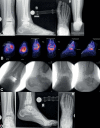Total ankle replacement
- PMID: 25837859
- PMCID: PMC4390826
- DOI: 10.3238/arztebl.2015.0177
Total ankle replacement
Abstract
Background: About 1% of adults suffer from painful osteoarthritis of the ankle. The current literature contains no information on the percentage of such patients who derive long-term relief of symptoms from conservative treatment. Advanced ankle osteoarthritis can be treated with non-joint-preserving measures, such as total ankle replacement and ankle fusion.
Methods: This review is based on selected relevant publications, guidelines from Germany and abroad, and the authors' personal experience.
Results: Before surgery is considered, conservative measures such as physiotherapy and orthopedic aids should be used to the fullest possible extent. No randomized trials have yet been published comparing total ankle replacement with ankle fusion. Total ankle replacement with newer types of prosthesis yields good to very good intermediate-term and long-term results, with mean success rates of up to 90% at 10 years (range, 68-100%). Independent risk factors for the failure of ankle replacement are age over 70 years (odds ratio [OR] 3.84), primary osteoarthritis (OR 7.19), post-traumatic osteoarthritis (OR 6.2), and type of prosthesis (e.g., single hydroxyapatite coating: OR 15.04). The average range of motion of the replaced ankle joint is 25° to 30°, with values as high as 60°.
Conclusion: Total ankle replacement is a good treatment option for complete, end-stage ankle arthritis. It can restore joint function and make the patient mobile with little or no pain. There are, however, many contraindications to be taken into account. There is a need for further studies of the biomechanics of arthritic and replaced ankle joints and for long-term follow-up studies of total ankle replacement.
Figures






References
-
- Barg A, Pagenstert GI, Hugle T, et al. Ankle osteoarthritis: etiology, diagnostics, and classification. Foot Ankle Clin. 2013;18:411–426. - PubMed
-
- Glazebrook M, Daniels T, Younger A, et al. Comparison of health-related quality of life between patients with end-stage ankle and hip arthrosis. J Bone Joint Surg Am. 2008;90:499–505. - PubMed
-
- Valderrabano V, Hintermann B, Horisberger M, Fung TS. Ligamentous posttraumatic ankle osteoarthritis. Am J Sports Med. 2006;34:612–620. - PubMed
Publication types
MeSH terms
LinkOut - more resources
Full Text Sources
Other Literature Sources
Medical

